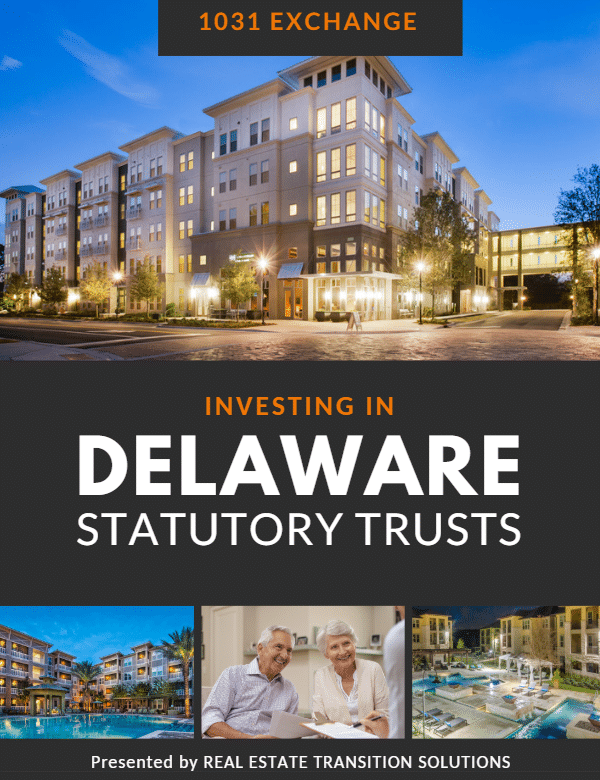Why Consider a Delaware Statutory Trust
1031 Exchange Advisor
What is a Delaware Statutory Trust?
A Delaware Statutory Trust is a real estate ownership structure where multiple investors each hold an undivided fractional interest in the holdings of the trust. The trust is established by a professional real estate company, referred to as “DST sponsor”, who first identifies and acquires the real estate assets. As individuals invest, their investments displace the capital used by the DST sponsor to acquire the property until it is eventually wholly owned by the investors. Investors own a beneficial interest in the trust. This means that investors hold a percentage of the ownership, and no single owner can claim exclusive ownership over any specific aspect of the real estate.
Key Benefits of a Delaware Statutory Trust
The DST ownership structure comes with many advantages, including tax benefits, income potential, the opportunity to buy ownership in an institutional-quality asset and—perhaps most notably—DSTs are eligible for 1031 exchanges.
DSTs stand out as a 1031 replacement property option for investors seeking passive income potential and diversified risk by allocating their 1031 exchange proceeds across multiple institutional-grade DST properties that are typically much larger and out of reach of most individual investors.
Delaware Statutory Trusts for 1031 Exchanges
A 1031 Exchange, named for Section 1031 of the U.S. Internal Revenue Code, is a transaction approved by the IRS that allows real estate investors to defer the tax liability or capital gains taxes on the sale of investment property. DSTs are considered direct property ownership for tax purposes, and as such, they are eligible for tax-deferred 1031 Exchanges.
To defer tax, the proceeds from the sale of the relinquished property must be reinvested into another “like-kind” replacement property of equal or greater value within 180 days of the closing date of the relinquished property. Tax deferral allows DST investors to preserve all of the equity from the sale of their relinquished property so it can continue working for them in their new DST replacement property.
The Basics for a 1031 Exchange work the same way for every property type, including DSTs. However, DSTs typically close within 3 to 5 business days following the sale of the relinquished property – a significant advantage considering strict 1031 exchange rules and deadlines.
Types of DST Properties
Nearly all commercial real estate property types are held as DST properties, including the four major property types—multifamily, office, industrial and retail—as well as niche property types, like senior housing, medical office and self-storage.
DST real estate is typically comprised of institutional-grade assets with competitive income potential. Due to the large purchase price of typically $30 million to $100 million, these assets would otherwise be unattainable for a typical individual investor, but are accessible through the fractional ownership offered by a DST.
Although DSTs can own multiple properties, they typically focus on a single property type. To diversify across different property types, an investor can invest in multiple DSTs.
DST Property Investment Examples (Closed Offerings)

Industrial DST Property
This industrial DST property is a triple net lease commercial property located in the Midwest. The property consists of a 1,009,259 sq. ft. distribution facility currently occupied by Amazon as a fulfillment center. Amazon has a remaining lease term of 13.4 years, with two 10-year extensions.

Multi-family DST Property
The DST is a stunning “Class A” multi-family community located in the southwest. Developed in 2018, the property is 94.9% occupied and consists of 256,628 rentable sq. ft. spanning across 5 acres. Nestled adjacent to a golf course, the community offers a unique live-work-play opportunity for residents.

Retail Net Lease DST Portfolio
The DST consists of 27 net lease essential retail properties located throughout the nation. The properties are 100% leased to 8 different high-quality tenants, all with proven track records and strong financials. The weighted average lease term of portfolio is 12 years. The portfolio offers a total of 430,757 rentable sq. ft.

Office DST Property
This office DST is a large 11-story absolute net lease office building located in the Midwest suburbs. The property is currently leased to Zurich American Insurance Company (a leading global insurance provider that insures 90% of Fortune 500 companies) with 25 years remaining and renewal options.
Advantages of a Delaware Statutory Trust
Perhaps the most compelling reason to invest in a Delaware Statutory Trust is the ability to defer, reduce and even eliminate taxes related to the sale of investment property using a 1031 Exchange. DSTs are also a popular passive real estate investment offering ownership in institutional-quality properties with minimal landlord responsibilities. Delaware Statutory Trusts offer several advantages as 1031 Exchange replacement properties:
Capital Gains Tax Savings
DSTs qualify as a like-kind property with a 1031 exchange. This allows real estate investors to defer paying capital gains taxes on the sale of an investment property, often resulting in significant savings. In some states, capital gains taxes can be as high as 42.1%, including federal capital gains tax, state capital gains tax, depreciation recapture tax and net investment income tax.
Greater Income Potential
Typically, DST properties are structured with an emphasis on cash flow. By acquiring high-quality institutional property in cities with strong projected growth, DSTs can focus on seeking to preserve investment value and greater income potential for investors. The monthly income varies from trust to trust depending on the property type and investment thesis, but often, independent investors may be able to generate more monthly income through the ownership of a DST property than through direct property ownership.
Institutional-Grade Properties
Although a DST can own nearly any real estate asset of any quality, the underlying real estate held by DSTs tends to be high-grade institutional property. Institutional-grade properties generally refers to a property of sufficient size and stature to merit attention from large national or international investors, and typically have the characteristic of high quality assets in major markets and at price points beyond the reach of individual investors and smaller partnerships.
Due to the rigid criteria established by the IRS for a DST to qualify as an exchange property, lower-quality assets are rarely eligible. As a result, DSTs often own high-quality assets with credit-worthy Fortune 1000 companies as tenants. If not for the DST structure, these properties would otherwise be unattainable for an independent investor to purchase via a 1031 exchange.
Passive Property Management
DSTs are passive investments. As such, individual investors have no participation in the daily management or operations of the DST real estate. Once you select a DST investment and acquire your ownership, your work is done. Through a 1031 exchange, investors can exit a management-intensive asset and shed landlord responsibilities without foregoing the benefits of owing investment real estate. This is a particularly attractive benefit for independent investors with major life changes ahead—for example, those entering retirement, growing a family or planning for an estate transfer.
Risk Diversification
DSTs have a comparatively low minimum investment requirement, usually $100,000, making it easy to diversify across multiple assets to help mitigate risk. Under the IRS’s property identification rules for 1031 exchanges, investors can reinvest the proceeds from an investment property sale into multiple DSTs, creating immediate investment diversification among different DST property types and locations.
Tax Savings for Estate Beneficiaries
DSTs also offer estate planning benefits. Through a step-up in basis, beneficiaries can defer capital gains, depreciation recapture and net investment income tax upon the death of an owner. The estate can also divide a DST investment seamlessly among beneficiaries, something that is generally challenging for traditional, directly-owned fee simple real estate assets.
As an illiquid investment with fractional ownership, a CPA is able to discount a DST investment when calculating the value of the total estate. It is not uncommon to see discounts ranging from 20% to 30%, which can serve to reduce potential estate taxes.
Low Risk of Exchange Failure
DST exchanges rarely fail because the real estate has already been vetted and acquired by the DST sponsor. Using a prominent 1031 Exchange Advisor helps reduce the probability of a failed exchange. Real Estate Transition Solutions thoroughly vets all DST sponsors and DST properties. We believe a quality-control process and higher-grade investment opportunities help lower risk of a failed 1031 exchange.
Ability to Close in 3 to 5 Days
Given the DST Sponsor has already acquired the properties within a Delaware Statutory Trust, investors can purchase the beneficial interests in the trust quickly compared to many other replacement property options. This is ideal for a time-sensitive 1031 Exchange or for those investors who value continuity in their income as DST investors can typically close within 3 to 5 business days following the sale of their relinquished property.
Disadvantages of a Delaware Statutory Trust
Like all real estate investments, investing in Delaware Statutory Trusts involve many of the same risks, including potential lack of return and loss of principal. As long-term, income-focused investments, DST performance is largely dependent upon the tenants’ ability to pay rent. This presents a few notable DST risks including lack of liquidity, interest rate risk, and changing market conditions. Additionally, some of the characteristics of a DST may not align with an individual’s investment goals including the lack of personal control over the investment.
A lack of management control can be both an advantage and disadvantage. After all, the passive nature of a DST is one of the characteristics that make this such an attractive investment option. The DST Sponsor puts in place a highly experienced team of real estate professional to manage DST operations. However, some investors prefer to participate in the property strategy and operations. For those investors, the DST structure would not be a good fit.
DST properties are typically held for 3 to 10 years. The DST sponsor has total control over the length of the investment and the exit. If an investor wants to exit early, the only option is to sell the DST interest to another accredited investor. The sale would also be subject to the same 1031 exchange guidelines, or the investor would be responsible for the capital gains tax due upon the sale. It should be noted there are DSTs that include liquidity via a 721 UpREIT.
As with any type of income-oriented real estate investment, investors may be subject to future vacancy rates and interest rate fluctuations, which could reduce cash flow potential and price appreciation. DSTs are also susceptible to changes in the IRS’s treatment of tax-deferred exchanges.
How a Delaware Statutory Trust Works
From an investor’s standpoint, Delaware Statutory Trusts may offer a less complicated and expedient closing process than other passive real estate options. The burden of identifying, purchasing, and managing the DST property(s) to be structured within the trust are the responsibility of a DST sponsor. The trust itself holds the title of the real property and the investors hold a beneficial interest in the trust.
DST Sponsors
A DST sponsor is the real estate company behind the trust. DST sponsors use their own balance sheet to identify and acquire the property(s) to be structured within the trust. Several properties will be carefully analyzed by the DST sponsor before selecting the best property for an offering. The DST sponsor creates the offering in the property for accredited investors, and it can jointly act as the trustee, manager and master lessee.
The DST sponsor typically arranges for a subsidiary to serve as “master tenant” to lease and maintain the assets of a DST and contracts with a professional real estate management company to manage the daily operations of the real estate, retaining all property management responsibility so DST investors can enjoy passive ownership.
The DST sponsor will market the DST offering to broker dealers to raise the equity required to fully fund the offering. The broker dealer will conduct due diligence and analysis on DST sponsors and their offerings to ensure they are appropriate for their registered representatives to offer to their clients.
DST properties are considered securities by federal and state regulators. To offer the DST property to accredited investors, registered representatives must hold certain securities licenses.
1031 DST Exchange Process
Understanding the tax liability on your relinquished property is generally the first step in the 1031 Exchange process. Consider consulting a 1031 Exchange Advisor before selling your investment property to ensure compliance with 1031 Exchange rules, a detailed understanding of your tax liability, and availability of suitable DST properties that seek to meet your financial and lifestyle goals.
Step 1 - Calculate Capital Gains Tax
Calculating the tax liability on the property you are selling is generally the first step in the Exchange process. Property owners can pay up to 42.1% in taxes related to the sale of their investment property depending upon the state the property is located and the amount of taxable gains – net proceeds less the original tax basis. The taxes applied to taxable gains are as follows:
- Federal Capital Gains Tax: 15% – 20%
- State Capital Gains Tax: 0% – 13.3%
- Depreciation Recapture Tax: 25%
- Net Investment Income: 0% – 3.8%
Step 2 - Understand 1031 Exchange Rules
It is critically important to understand 1031 Exchange rules and timeline for an Exchange before getting started. IRS exchange rules are very rigid, and the 1031 exchange timeline must be strictly followed to qualify for tax deferral. Seven key rules apply to every 1031 Exchange:
- The exchange must be set up before a sale occurs
- The exchange must be for like-kind property
- The exchange property must be of equal or greater value for full tax deferral
- The property owner must pay depreciation recapture tax and / or capital gains tax on “boot”
- The taxpayer that sold the relinquished property and acquired the replacement property must be the same
- The property owner has 45 days following the close of the relinquished property to identify replacement properties
- The property owner has 180 days following the close of the relinquished property to complete the exchange.
Step 3 - Set Financial & Lifestyle Objectives
Setting financial and lifestyle objectives are critical steps with every 1031 Exchange. These objectives should be based on what you are looking to accomplish today and well into the future. Identifying and selecting replacement properties should be based on key objectives including risk tolerance, cash flow and appreciation goals, liquidity, desire for management control, and estate planning needs.
Step 4 - Assess 1031 Replacement Property Options
Identifying a suitable replacement property can be a challenging and stressful process. So much so, that we recommend assessing potential replacement properties before listing your relinquished property. Several factors must be carefully considered when seeking to align the exchanger’s financial and lifestyle goals with the right ownership structure, locations, property types, and property attributes for replacement properties.
Real Estate Transition Solutions is constantly analyzing DST sponsors and offerings to recommend 1031 Exchange properties that seek to align with each investor’s financial and lifestyle goals and replacement property preferences. Accredited investors can request access to our catalog of open DST offerings vetted and updated monthly.
Step 5 - Engage a Realtor to Sell Your Relinquished Property
Once you are comfortable with the types of replacement properties available, select a realtor/broker to get your existing investment property (relinquished property) listed and under contract.
Step 6 - Engage a Qualified Intermediary
Once the relinquished property is under contract, the investor can engage a Qualified Intermediary to facilitate the exchange. When the sale of the property closes, the qualified intermediary holds the proceeds from the transaction and releases the proceeds to acquire the selected replacement property.
Then, the clock starts ticking. Once the sale of the relinquished property closes, the investor has 45 days to identify replacement property and 180 days to complete the exchange.
Step 7 - Identify Replacement Properties (45-Day Rule)
The 45-Day Rule requires that your replacement property be identified within 45 days of the close of your relinquished property (by calendar day 45, your qualified intermediary must be notified of the identified replacement property). You do not need to acquire all identified replacement property, however after day 45, no new properties can be added to the submitted identification.
Step 8 - Close on Replacement Property (180 Day Rule)
Another important milestone within the 1031 Exchange timeline is the 180-Day Rule. Within 180 days after closing on your relinquished property (135 days following the end of the identification period), you must close on the purchase of your replacement property.
Popular Articles
Over the last two decades, commercial real estate (CRE) has taken an esteemed seat at the investment table alongside equities, bonds and cash—and it is clear why. CRE may provide greater income…
Many factors should be considered when evaluating DSTs, including DST sponsor and investment structure, property status, tenant profile, market and neighborhood dynamics, and the local economic and regulatory environment.
There comes a time for most investment property owners when actively managing investment property no longer fits their objectives. We write and consult extensively about various options owners have available to them to eliminate active management…
It is called the Amazon Effect—and you’ve probably heard a lot about it. The ecommerce giant has reshaped, well, nearly everything, from the way that consumers think about shopping and accessing goods to the global supply chain.
Send this email
Send this text message
Share this post message
I had a great experience working with Taylor Armstrong. You will find his contact info and helpful resources on this website.
Download
FREE DST Guide
- What is a DST?
- How DSTs Work
- Benefits vs. Risks
- 1031 Rules for DSTs
- 1031 Options for DSTs






